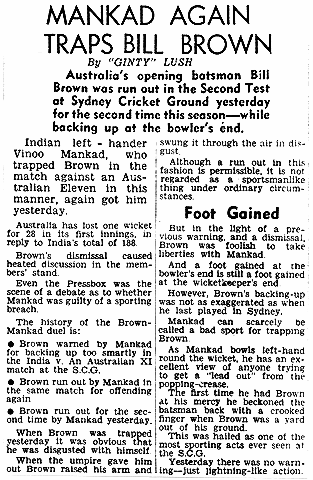To Mankad or not to
Ian Chappell bats for the bowlers’ cause at ESPNcricinfo:
In most mankad situations the batsman is trying to take advantage – cheating, if you will – and yet the bowler, who is abiding by the law, is vilified. For any batsman who gains a start before the ball is delivered, the advantage is enormous in the short forms of the game; it can also help in the longer versions.
Mike Atherton at the Times (behind paywall) settles the debate by invoking a friend from Ashwin’s hometown, Chennai:
Interestingly, I had a text from a friend yesterday from Chennai, Ashwin’s hometown, who said that such dismissals are regularly seen during the ruthless floodlit 15-yard soft ball matches played during the steaming summer nights in the city, where every inch counts. Short-form franchise competitions mirror native playground games more and more (or the other way around), was his gist, and no one who has played in those games thinks of it as a moral issue.
In the Kolkata Telegraph, Mukul Kesavan wonders if cricket can borrow from baseball rules for Mankading:
Ultimately, despite the outrage and disapproval, this isn’t a moral question, it’s an aesthetic one. The question is, how much action can you have at the non-striker’s end without disturbing the bowler-striker tableau that defines the game? Or to put it another way, if Mankading were to become a regular form of dismissal, would cricket become baseball?
Abhishek Mukherjee at Cricketnext.com on the history of mankading.
***
White noise
Gideon Haigh makes a spirited case (behind paywall) against the proposed change for adding numbers to Test players’ jerseys:
There’s nothing particularly highbrow about this, by the way; it’s simply anti-obvious, anti-stupid. But maybe I can put it more succinctly. OK here goes. Numbers and names on white clothing. Look. Like. Shit.
What’s proposed, then, is an initiative from which a minuscule degree of accessibility will be gained at an aesthetic and cultural cost which nobody will trouble to calculate because it cannot be reduced to dollars and cents.
Greg Baum, at the Age, thinks it’s just fine:
Inscribed names and numbers won’t change the way Test cricket is played, as floodlights and pink balls do, for instance. They offend only the most abstract ideal of cricket. They’re not a gimmick. They’re not for the kiddies, or not only for them. They won’t add to the surfeit of noise and clutter. They won’t lessen the mystique. They won’t set us again on the slippery slope, eyesore upon eyesore, one defilement after another, that leads inexorably to AFLX.
Arunabha Sengupta, at cricmash.com, applies the historian’s lens on cricket’s colourful iterations of attire before whites became a convention.
***
The Independent’s Jonathan Liew does a deep dive on the Brexitian wait for The Hundred:
The avalanche of negative publicity that overwhelmed the launch of The Hundred may not ultimately have forced a change of course, but it has impelled a softening of tone. The ECB’s head of communications, Chris Haynes, will leave his position next month. An external PR company has been sought to deal specifically with the torrid media fallout. The message has subtly shifted from a single-minded focus on “new audiences” to “new and existing audiences”, an admission that existing fans are not simply the bread and butter of the game, but a vital marketing resource, spreading the gospel to their own social circles.
TR Vivek reminisces about the television show Sunil Gavaskar Presents at The Hindu
***
